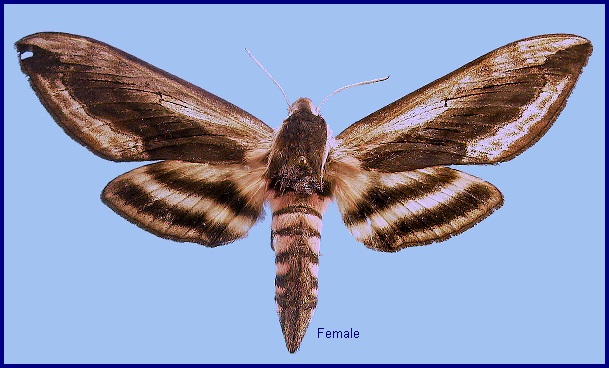
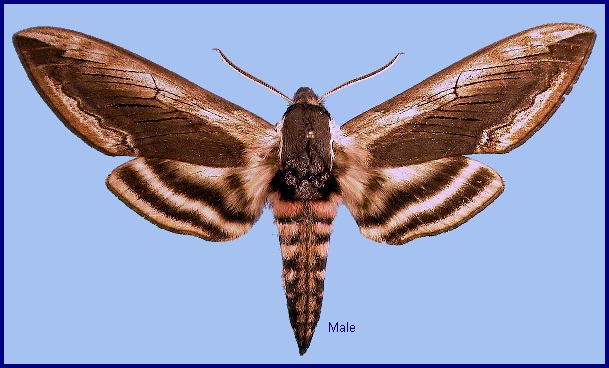

Sphinx ligustri Linnaeus, 1758, Syst. Nat. (Edn 10) 1: 490. Type locality: not stated [Sweden].
Synonym. Sphinx spiraeae Esper, [1800], Die Schmett. (Suppl.), (Abschnitt 2): 21.
Synonym. Sphinx ligustri amurensis Oberthür, 1886, Bull. Soc. Ent. France (6)6: 56.
Synonym. Sphinx ligustri albescens Tutt, 1904.
Synonym. Sphinx ligustri brunnea Tutt, 1904.
Synonym. Sphinx ligustri incerta Tutt, 1904.
Synonym. Sphinx ligustri intermedia Tutt, 1904.
Synonym. Sphinx ligustri lutescens Tutt, 1904.
Synonym. Sphinx ligustri obscura Tutt, 1904.
Synonym. Sphinx ligustri pallida Tutt, 1904.
Synonym. Sphinx ligustri subpallida Tutt, 1904.
Synonym. Sphinx ligustri rosacea Rebel, 1910.
Synonym. Sphinx ligustri nisseni Rothschild & Jordan, 1916, Novit. zool. 23: 253.
Synonym. Sphinx ligustri grisea (Closs, 1917).
Synonym. Sphinx ligustri fraxini Dannehl, 1925.
Synonym. Sphinx ligustri perversa Gehlen, 1928.
Synonym. Sphinx ligustri chishimensis Matsumura, 1929, Insecta Matsumurana 3: 165--168.
Synonym. Sphinx ligustri seydeli Debauche, 1934.
Synonym. Sphinx ligustri brunnescens (Lempke, 1959).
Synonym. Sphinx ligustri postrufescens (Lempke, 1959).
Synonym. Sphinx ligustri cingulata (Lempke, 1964).
Synonym. Sphinx ligustri weryi Rungs, 1977, Alexanor 10: 187.
Synonym. Sphinx ligustri eichleri Eitschberger, Danner & Surholt, 1992.
Synonym. Sphinx ligustri zolotuhini Eitschberger & Lukhtanov, 1996, Atalanta, Würzburg 27(3-4): 615.
Note. Eitschberger & Lukhtanov (1996) described Sphinx ligustri zolotuhini from Kazakhstan, stating that it could be "differentiated from the nominate form by its smaller size and the total absence of any brown tones, especially on the forewing uppersides. The area below the costal vein of the forewings is pure white, more or less strongly dusted with black scales. The fringes of the hindwing are black and not dark brown as in the nominate form". In fact, this description matches that of Sphinx ligustri amurensis. However, Kitching & Cadiou (2000) argued that there are no discontinuities in either distribution or habitus between this latter taxon and nominotypical Sphinx ligustri. So, for example, specimens from Shihezi and Ürümqi, China, fall well within the range of normal variation displayed by European populations of Sphinx ligustri. Consequently, they concluded that there was no justification for recognizing subspecies within Sphinx ligustri.
[Further details on this species in Japan, as well as photos of many stages, can be found on Digital Moths of Japan.]
Wingspan: 64--100mm; generally smaller than in Europe. Difficult to confuse with any other Palaearctic hawkmoth. Exhibits great variation: pink entirely replaced by grey (f. grisea Closs); pink replaced by white on the hindwings and abdomen only (f. albescens Tutt); abdominal 'ribs' yellow (f. lutescens Tutt). Numerous other minor variations occur in which pink, brown or black pigments are extensive. In the Hungarian Depression, a pale form occurs which was once thought to be a distinct species (Sphinx spiraeae Esper, [1800]), with the larva feeding on Spiraea; a similar and smaller pale form occurs in the drier regions of Central Asia (Eitschberger & Lukhtanov, 1996). There is no sexual dimorphism, although most females are generally larger than males.
In the male genitalia, uncus long, subcylindrical, gently curved, distally flattened, apex divided into two sharp points. Gnathos with a very long horizontal lobe divided into two long, slender, cylindrical, tapering processes. Valve broad, dorsally rounded, ventrally oblique, broadly rounded apically. Harpe ending in a broad, concave plate, the ventro-distal margin of which is turned up and slightly notched, whereas the oblique dorsal edge is irregularly dentate. Juxta rounded. Phallus ending in a short, broad, obtusely rounded process. In the female genitalia, ostial plate distinct from those of related species: the ostium is proximal; the middle of the post-ostial plate is flat, slightly concave laterally, convex mesially, smooth, bordered laterally by an oblique fold, which is often irregularly folded transversely.
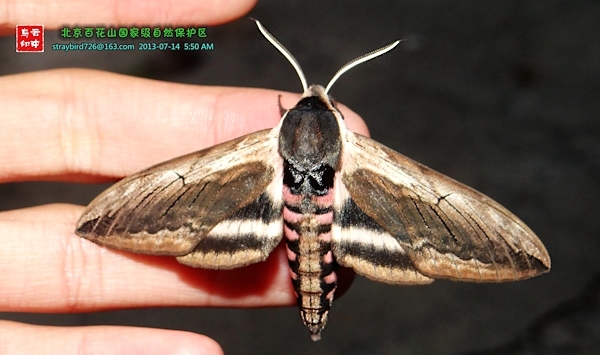
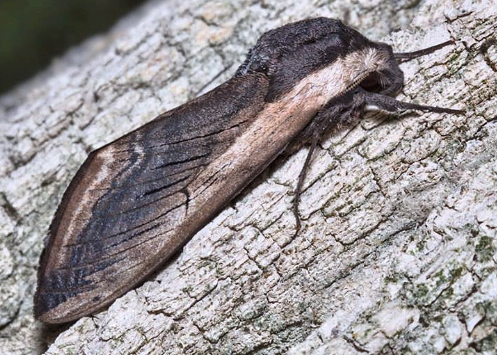
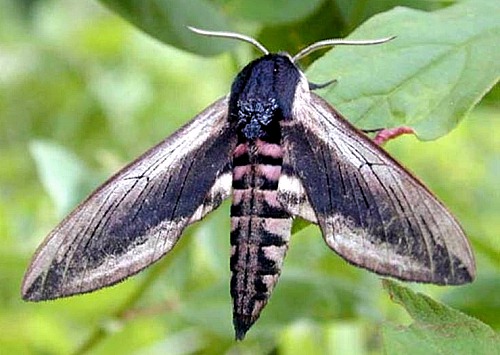
Common in temperate woodlands and riverine habitats across the northern half (Loess Plateau) of Shaanxi.
China: 26.iv (Beijing); 9.v (Beijing); 8-20.vi (Xinjiang; Nei Mongol); 16-25.vi (Jilin); vii (Nei Mongol; Heilongjiang; Beijing); vii (Jilin); 26.vii-2.viii (Beijing); viii (Heilongjiang). Mongolia: 18-21.v (Khovd Province); 6.vi (Khovd Province); 11-15.vii (Khovd Province; Gov'-Altai Province). North Korea: vi (Sinmi-do). South Korea: 2.viii (unstated locality). Russia: 24.v-25.vii (Khabarovskiy Krai); 29.v (Primorskiy Krai); 5-30.vi (Siberia, Tomsk); 8-29.vi (Primorskiy Krai); 20.vi (Altai); 26-29.vi (Siberia, Novosibirsk area); 27-30.vi (Amurskaya); 3.vii (Siberia, Irkutsk area); 4-21.vii (Khabarovskiy Krai); 7.vii-4.viii (Primorskiy Krai); 10.vii (Transbaikalia); 26-29.vii (Altai). Japan: 6.vi-18.viii (Hokkaido).
In northern China there are one or two generations a year, with adults flying from May until August (Yang, 1978).
Park et al. (1999) give early July until late October as the flight period in Korea.
OVUM: Pale green, elliptical (2.08 x 1.50mm), dull but smooth. Up to 200 eggs are laid by each female on the underside of the leaves of the hostplant, usually singly, although two or three together are not uncommon. This stage lasts from 9--20 days, depending on temperature.
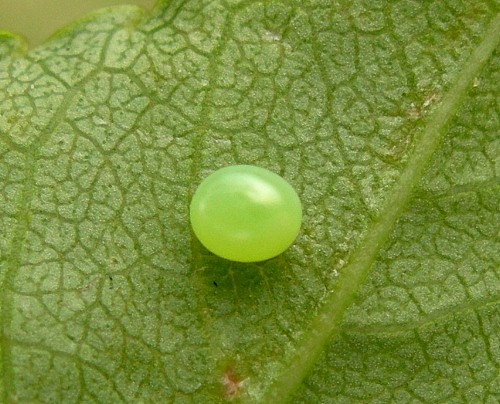
LARVA: Full-fed 80--90mm. Dichromatic: usually green; also a rare purple form.
On hatching, the larva measures approximately 5mm and is pale yellow with a long dark horn. The eggshell is not eaten. With feeding, the primary colour changes to luminescent green, speckled with yellow tubercles. After the first moult, lateral streaks appear as a series of dots, their final white and purple colours not developing until the third instar; the yellow tubercles disappear in the last. Variation is not great, but some larvae have darker than normal side stripes, often complemented by a second, lower purple one. Others may have two or more horns in series, each successively smaller. In others, occasionally the primary body colour of green may be replaced by purple, but this form is very rare.
Young larvae rest beneath the midrib of a leaf, but when fully grown they assume a typical upside-down sphinx-like attitude, clinging to a petiole or stem by their anal and last two prolegs, with the thoracic segments hunched. Specimens feeding on Ligustrum or Syringa are mostly to be found clinging to stripped shoots within two metres of the ground, as are also many of those on Fraxinus, with saplings being preferred to mature trees.
The larval stage lasts between four and seven weeks, after which the green colour is replaced dorsally by purplish brown before the larva descends in search of a suitable pupation site.
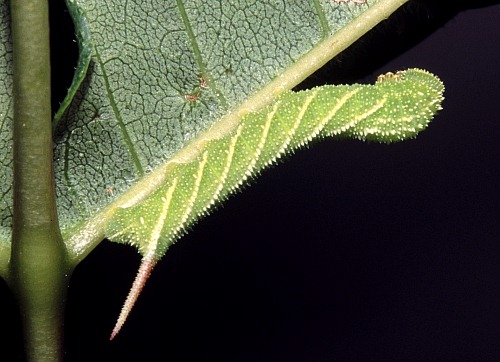
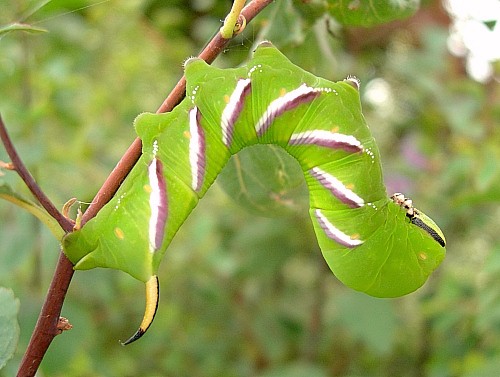
PUPA: 45--50mm. Rich, glossy brown. Pupation normally takes place in soft, loamy soil up to 10cm deep, in a hollowed-out chamber lined with a few strands of silk. The overwintering stage.
Larval hostplants. Recorded in China on Fraxinus, Ligustrum, Philadelphus and Syringa (Yang, 1978; Chu & Wang, 1980), as well as Forsythia suspensa (Thunb.) Vahl. In fact, this last shrub (and other members of the genus) appear to be a major host in the Haidian District of Beijing (Vyacheslav Ivonin & Yanina Ivonina, pers. comm. 2022). However, a record from Citrus is certainly erroneous.
Recorded in Amurskaya, Russia, on Syringa reticulata subsp. amurensis and Vaccinium uliginosum (Streltzov, Osipov & Malikova, 2003). In July 2021 two full-grown larvae were also found on Salix schwerinii E. L. Wolf in the Khasan District of Primorskiy Krai, Russian Far East (Vyacheslav Ivonin & Yanina Ivonina, pers. comm. 2022).
Recorded in Korea on Ligustrum obtusifolium, Syringa reticulata, Fraxinus rhynchophylla, Spiraea prunifolia, Spiraea thunbergii and Vaccinium (Park et al., 1999).
Elsewhere, Sphinx ligustri is found on Aquifoliaceae, Caprifoliaceae, Oleaceae and Rosaceae, with occasional records from several other families.
Unknown for the region.
China: Xinjiang (Altai Mountains; Shihezi; Ürümqi; Yining/Gulja; Xiaerxili Natural Reserve, near Bole City, Bortala Mongol Autonomous Prefecture); Nei Mongol (Zalantun/Butha Qi; Chifeng/Ulanhad, Daguangdingzishan, 2061m; Ergun Youqi); Heilongjiang (Hailin); Jilin (Jiaohe, Lafa Shan); Liaoning (Changhai, Dachangshan Island); Beijing (Sanbao; Baihua Shan; Puwa, 1100m; Haidian; Beijing Botanical Garden); Shandong (Mt. Laoshan, nr. Qingdao; Yaoxiang National Forest Park); Shaanxi (north).
Mongolia: Khovd Province (Bodonchijn River basin, Hundijn River valley, 1600m (46°06'N 92°30'E); Bulgan River basin, Dod-Naryjn River valley, 1500-1700m; Bajtag-Bogd-Uul Mts., Baruun-Khargaityn-Gol (River) valley, 1900–2000m (45°16'N 90°57'E)); Gov'-Altai Province (Mongolian Altai Mts. (south slope), Mogoijn River valley, 1800m; Adzh-Bogdo Mts. (south slope), Il River valley, 2500m); Bayanhongor Province (Bogd Sum, 33km SW Bogd, Orog Nuur [lake]); Töv Province (Lün Sum, 19km SW Lün; Argalant); Selenge Province (Tunkhel village, Khailaast; Baruun kharaa soum, Bayangol).
North Korea: North Pyongan Province (Sinmi-do; Chonma-san); South Hamgyong Province (Pulgaemi ridge above Pukchong City, 1500m).
South Korea: Seoul (Seoul; Cheongyang-ri); Kyonggi Province (Suwon; Suri-san; Gwangleung; Cheonma-san; Myungji-san; Asan Bay; Pyungtaek); Kangwon Province (Nochu-san; Chiak-san; Hoengseong-dam; Donghae; Chuncheon; Jiam-ri; Bongmyung-ri; Gyebang-san; Hongcheon; Dunnae); North Chungchong Province (Chupungryung; Minjuji-san; Songni-san; Wolak-san); South Chungchong Province (Gyeryong-san); North Cholla Province (Jiri-san; Muju; Namwon); North Kyongsang Province (Sobaek-san); South Kyongsang Province (Gibaek-san; Hamyang; Yeohang-san; Muhak-san; Sancheong; Uiryong; Hadong; Hapcheon).
Japan: Northern and central Hokkaido (Kushiro; Azuma; Tomakomai; Hamanaka).
Russia: Altai (Artybash; Cherga; Ust-Kamenogorsk; Elekmonar); Siberia (Tomsk; Kiree'sk; Alaevo; Karasuk; Chingisy; Kourak; Kharat); Tuva ASSR (Turan); Buryatia (Dzhirga; Istok; Onokhoy village); Transbaikalia (Ur'upino Piquet; Nizhnii Tsasuchei; 20 km N Chita; Mogocha; Argunsk; Shara; Sokhondinskii Nature Reserve (Agutsa, Nizhnii Bukukun); Bogomyakovo; Undino-Posel'e; Budymkan); Amurskaya (Belogorsk; Zeiskii Nature Reserve; Uril area; Blagoveshchensk; Zeya; Norsk; Pashkovo, and from many other locations); Yevreyskaya (Bastak Nature Reserve); Khabarovskiy Krai (Bolshekhekhtsyrskii Nature Reserve, Khabarovsk suburbs; Slavyanka; Komsomolsk-na-Amure; Pivan; Kiselevka; Mariinskoe; Arkhangelskoe; Nikolaevsk-na-Amure; Botchinskii Nature Reserve; Tumninsky Nature Reserve; northern Bureinskii/Bureya Hills); Primorskiy Krai (Ussurysk; Khasan; Narva; Teplyi Klyuch; Kedrovaya Pad Nature Reserve; Novovladimirovka; near Kalinovka; near Zanadvorovka; near Barabash; Vityaz Bay); Sakhalin Island; Kurile Islands.
Found throughout the Palaearctic Region, from the Iberian Peninsula, British Isles (but not Ireland or Scotland) and southern Scandinavia, through western and central Russia, the Central Asian Republics, Mongolia (Knyazev, Makhov, Matov & Yakovlev, 2020; Enkhtur, Brehm, Boldgiv & Pfeiffer, 2021; Makhov, Matov & Lukhanov, 2024), down to (maybe) northern Pakistan (Humairah Hanif et al., 2016) and (maybe) northwestern India (Smetacek, 1994), and east to Amurskaya (Streltzov, Osipov & Malikova, 2003), Primorskiy Krai, the Kuril Islands and Hokkaido. Sphinx ligustri occurs in the area south of the boreal coniferous forest zone and, in Central Asia and Mongolia, north of the arid steppes.
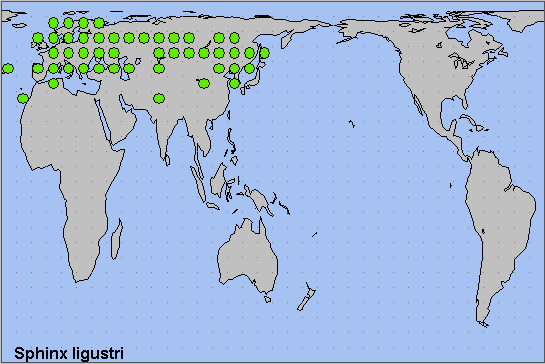
Holarctic; Palaearctic region. Pleistocene refuge: Polycentric -- Pontomediterranen and Atlantomediterranean subsections of the Mediterranean refuge, as well as the Manchurian refugium.
 Return to Sphingidae of the Eastern Palaearctic species list
Return to Sphingidae of the Eastern Palaearctic species list